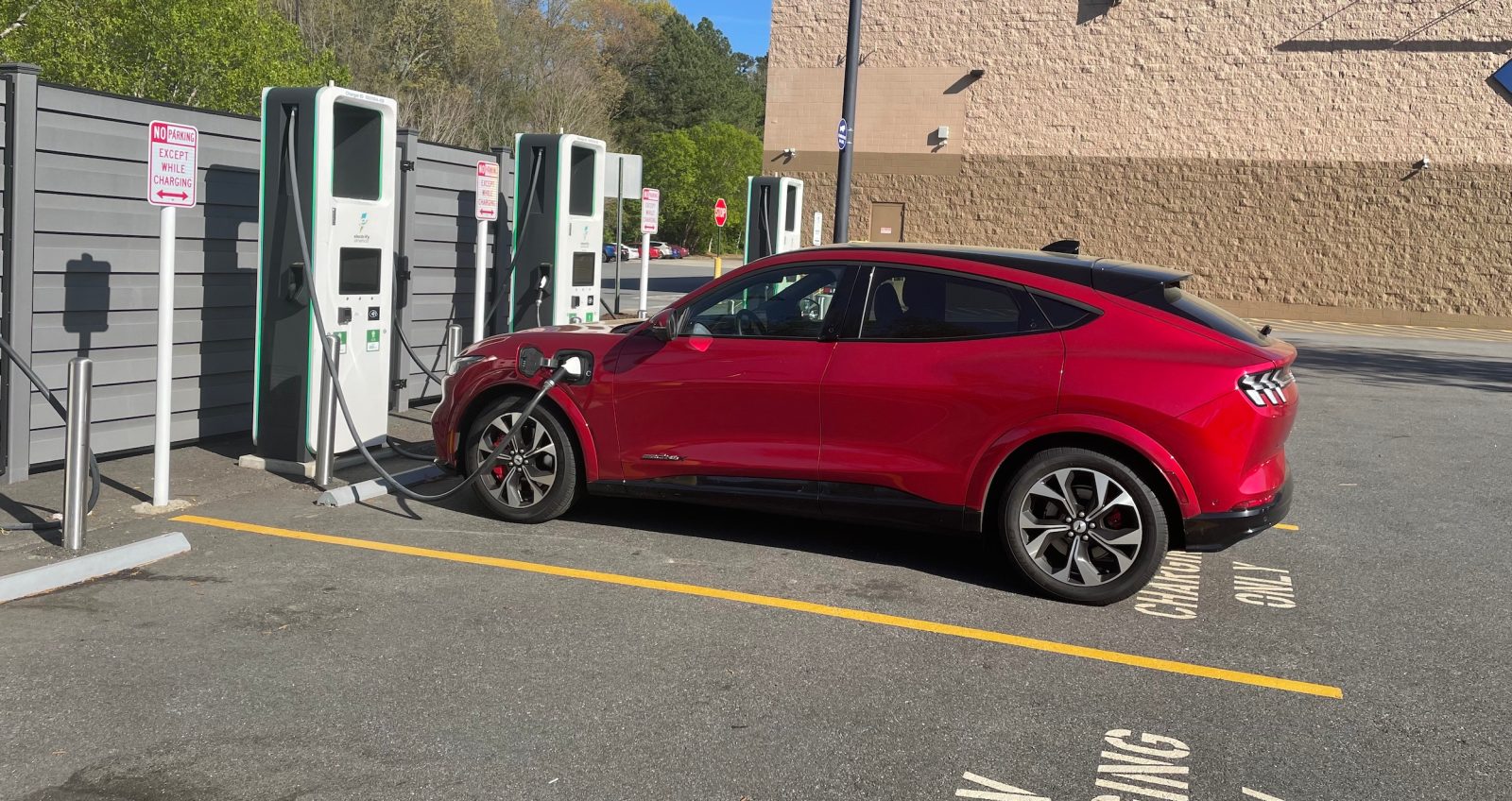
Last month, I set out on a road trip in a Ford Mustang Mach-E in the south of the US from Asheville, North Carolina to Jackson, Mississippi, and back to see if the traditionally more conservative region is ready for the electric revolution.
Here’s my account of the experience.
My girlfriend is from Jackson, Mississippi, but she lives in Asheville, North Carolina right now.
I flew into Asheville where Ford kindly delivered a Mustang Mach-E Extended Range press vehicle. I already drove this version of the Mustang Mach-E before and positively reviewed it. With an estimated EPA range of 305 miles, I knew it would be a good test subject for this trip.
The idea was to drive the car around Asheville for a few days and then set out on the road trip to Jackson while stopping in Birmingham, Alabama along the way to visit friends.
Ford delivered the car with 100% charge, which proved to be useful since I couldn’t charge at my girlfriend’s place since she only has street parking. Obviously, this is not an ideal situation. Overnight home charging is one of the best things about driving electric.
In our case, it wasn’t that much of an issue because we had plenty of range to drive around the greater Ashville area for a week. We actually got around quite a bit. We drove to Hendersonville and Black Mountain to pick up used electric bikes and drove to a few restaurants in town.
By the end of the week, we still had over 50 miles of range.
The goal was to stop to visit friends in Birmingham, Alabama for a few days and then drive to Jackson, Mississippi to be with my girlfriend’s family for Easter.
We went to an Electrify America station in Asheville to get charged up for the trip. It wasn’t a good start since the first charger we tried wouldn’t work, but we moved to another stall that was fortunately free and started charging.
It charged at up to 142 kW before leveling down. We got to 95% state-of-charge in about 30 minutes and set out on the trip:

The plan was to stop around Atlanta to charge and grab some food before heading to Birmingham.
The drive was easy. We knew we didn’t need to worry about the range to make it to Atlanta, which has plenty of fast-charging options, so we drove between 70 and 75 mph (113 to 120 km/h) using Ford’s Blue Cruise, which works great on highways.
We stopped at the Electrify America station at the Sugarloaf Mills mall outside of Atlanta. The first leg of the trip was 174.9 miles, and we achieved an efficiency of 3.3 miles per kWh:
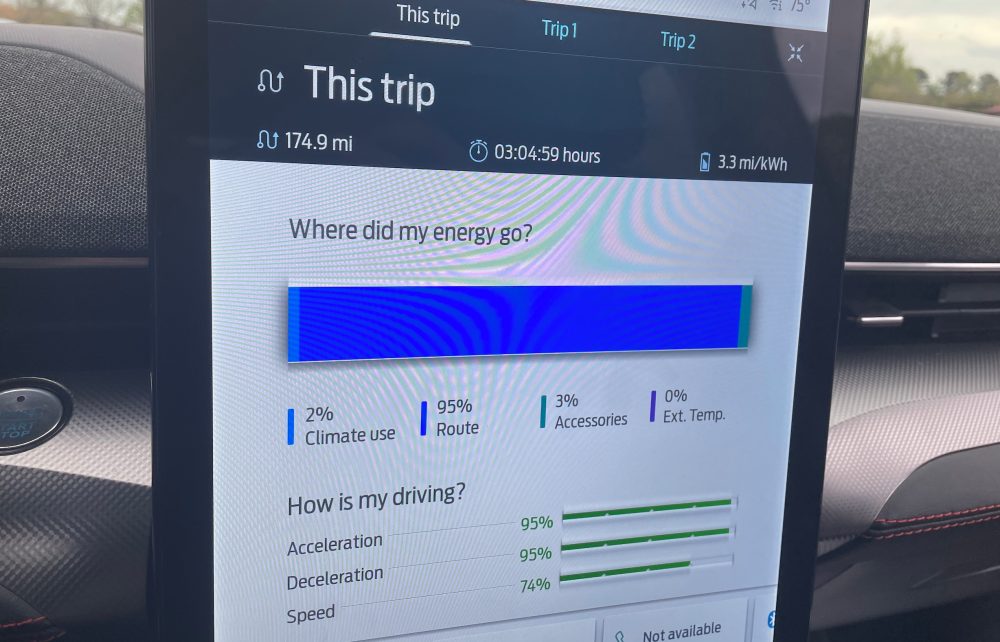
This time, it was a smooth charging experience. The first CCS1 charger that we tried, worked. We simply plugged in and walked into the mall for dinner.
By the time we were back about 45 minutes later, the Mustang Mach-E was charged at up to 91%, and it cost us just $13.76:

Again, we knew we had plenty of charge to get to Birmingham, and therefore we wouldn’t have to worry too much about our efficiency during that leg of the trip, either.
We drove at a similar speed and made the 172.1 miles in 2h55 with 3.1 miles per kWh efficiency:
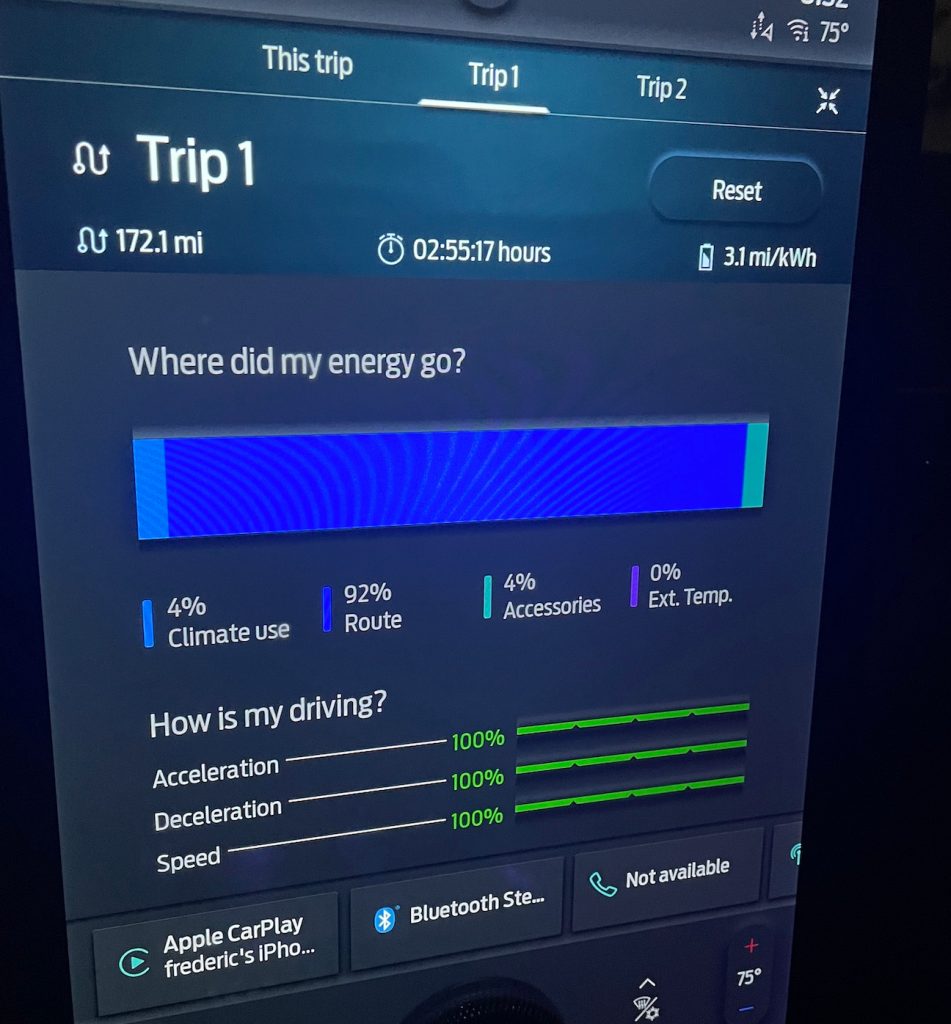
Now I had the same problem in Birmingham as I did in Asheville: I didn’t have access to overnight charging due to having only street parking where we were staying.
I felt like I had enough range to get around town for a few days, but we needed to charge again before heading out to Jackson, Mississippi.
That’s where our southern electric road trip started to become less convenient than if it was in a gas-powered vehicle.
The closest fast charger to Birmingham is an Electrify America station at a Walmart about 20 miles south of the city:
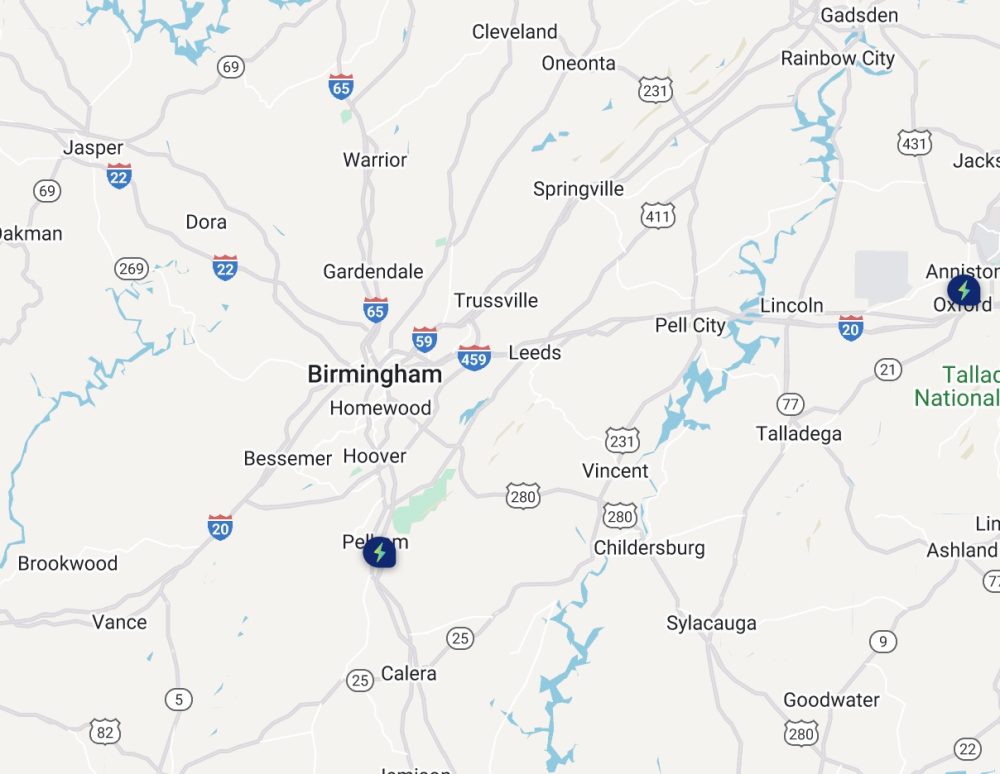
This added a significant detour, which again we could have avoided if we had overnight charging where we were staying, but we, unfortunately, didn’t.
The first charger we tried to use at the station didn’t work because the credit card reader wasn’t functional, but the other charger was free to use and worked.
We also needed a full charge to get to Jackson, which we knew was going to be the most stressful part of the trip because there are no fast-charger along the way, it’s the longest of all the legs on the trip, and there are limited charging options once we got there.
Since I had driven all the way to Birmingham, my girlfriend drove that leg of the trip. I let her know that we had only about 10 miles of wiggle room to make it to our hotel in Jackson, where we had a level 2 charging station waiting for us, and therefore, we needed to be efficient with our driving.
That means not driving too fast and not using climate control, but I forgot to mention that last part to her since it was nice out and I didn’t think we’d need any heat or AC. Do you see where this is going?
I made the mistake of falling asleep and I woke up about three hours into the drive to my girlfriend comfortably driving with the heat at 78 degrees and even the heated steering wheel at max heat. We had less than 10 miles between the displayed range and the distance remaining to get to our hotel.
After letting her know that those features use the same energy from the battery powering the motor and that us getting there is more important than our comfort right now, we slowed down a little and made it to our destination with 17 miles left:
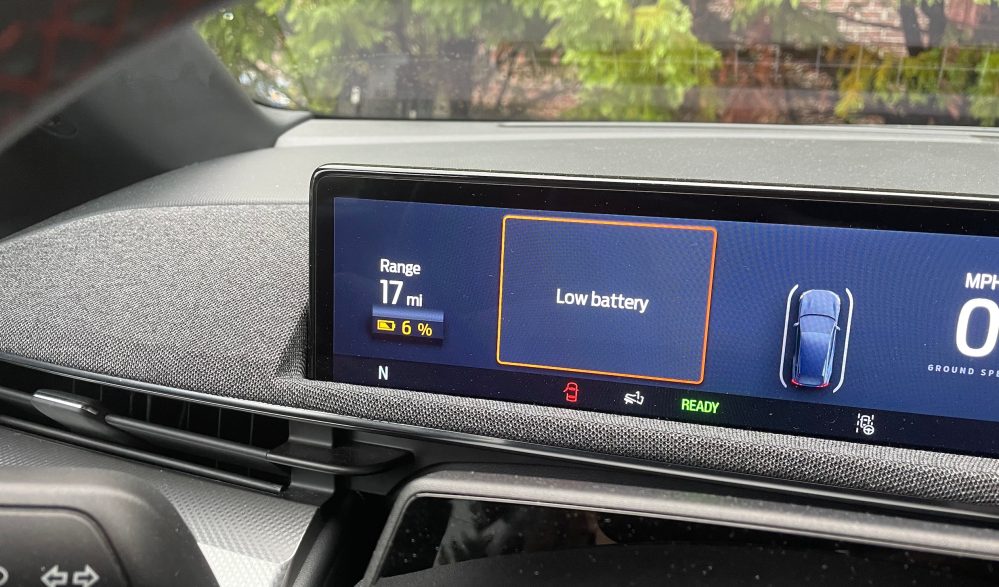
It certainly was a bit more stressful than a normal road trip, but it’s a stress that would have been easily avoided by simply having a fast-charger between Jackson and Birmingham.
We ended up completing that 244-mile leg of the trip in 4 hours and 16 minutes:

Only one of the two J1772 chargers at the hotel was working, but it was fortunately available. I let the hotel know about one of the chargers not working and they were already aware and didn’t seem too concerned about it.
We spent less than 24 hours in Jackson and then had to make our way back to Asheville by Monday morning.
The level 2 charger was enough to give us a full charge by the time to leave in the morning.
On our way back, our best option was again the Electrify America charger 20 miles south of Birmingham. We again had to be super efficient until we made it to that charging station, which we did and this time with about 20 miles of range left.
After that, the trip back to Asheville was easy with again just another stop around Atlanta.
Can You Drive Electric in the South?
First of all, let me start by saying that there’s always a way to make it work when it comes to driving electric. All you need is an electric outlet and those are virtually everywhere in the modern world. It’s part of the charm of EV technology.
It’s like having millions of tiny gas stations that slowly pump gas everywhere.
So the short answer is yes, you can drive electric in the south of the US, but it’s not really the right question to be asking.
We are talking about convenience here. Is it as convenient as a gas-powered car? That’s the real question and the answer is no – not if you regularly have to travel between southern cities.
Humans are creatures of habits and for EV adoption to expand, you need to make electric vehicles as convenient or more convenient than their gas-powered counterparts or people won’t change their habits.
You cannot expect most people to be willing to take a 40-minute detour in order to go charge before a road trip, like we did between Birmingham and Jackson.
That’s why fast-charging stations need to be readily available at convenient locations in order to support broader EV adoption.
The good news is that you have a bunch of new stations in the work between Birmingham and Jackson and along other popular routes in the south (the wrenches indicate planned stations):

But there’s still a lot of work to be done in the south.
Electrify America has arguably the best fast-charging network in the US for non-Tesla vehicles, and it has an obvious dead zone on its network in the south:
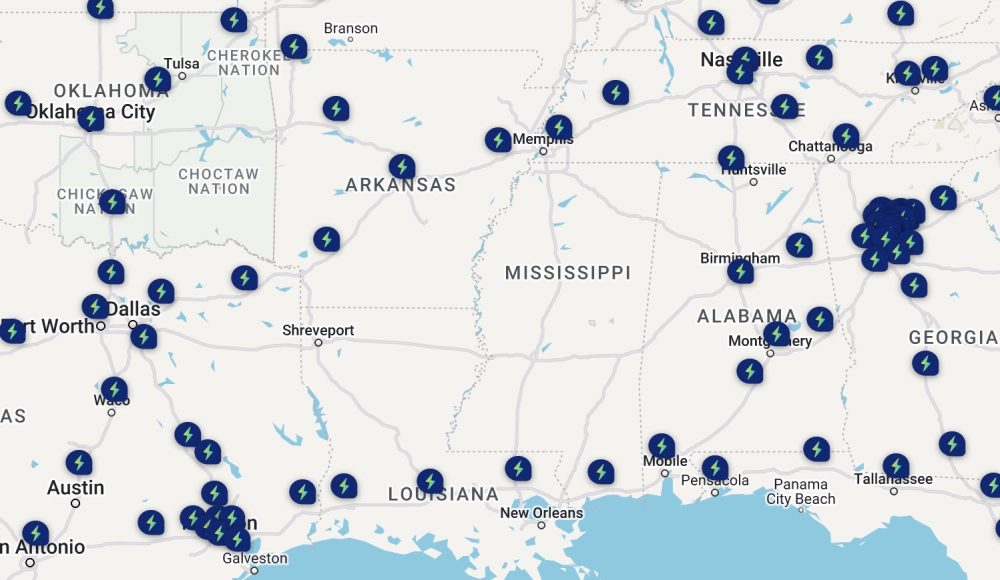
The company is going to have to fix that if it aims to become the gold standard for EV charging networks.
It’s not like they don’t already have a blueprint on how to make it work…
What if you did the trip in a Tesla?
Now if we had set out on this trip in a Tesla, it would have been a lot easier thanks to the Supercharger network along the same route:

Like with the Mustang, it wouldn’t have been a problem between Asheville and Atlanta and then getting us to Birmingham, but after that, it would have made things a lot less stressful.
I wouldn’t have to get 20 miles out of town to get a fast-charge before leaving since there are two Supercharger stations in Birmingham.
Then, we wouldn’t have to worry about how efficiently we need to drive on our way to Jackson since there’s a Supercharger in Meridian along the way, and another one in Jackson itself for the way back, in case you can’t get overnight charging.
While the gap is closing, the Supercharger network is still a giant advantage for Tesla in many regions where other charging networks are still catching up. This is something that automakers who are serious about electric vehicles need to address.
FTC: We use income earning auto affiliate links. More.




Comments